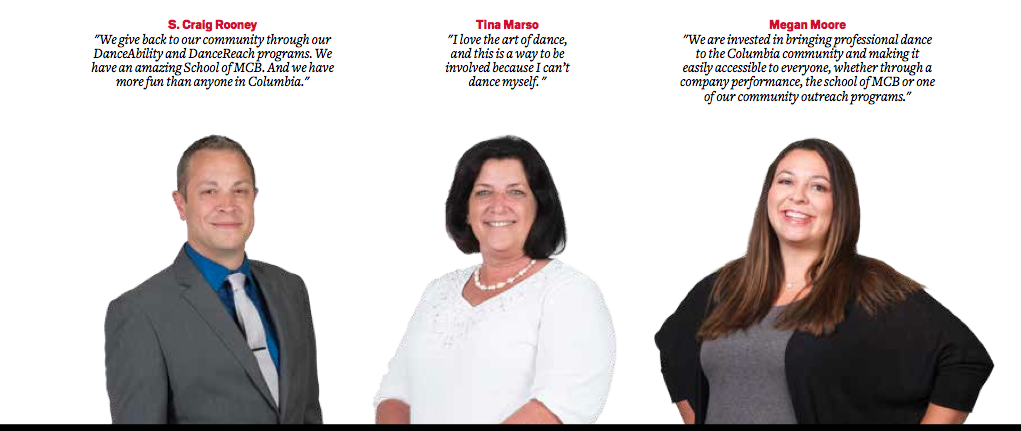Nonprofit Spotlight: Missouri Contemporary Ballet
In 2006, Karen Mareck Grundy saw a void in the Columbia community. As progressive as the city was, she says, especially in the arts, dance was an essential niche needing to be filled. And so began mid-Missouri’s only professional ballet company, Missouri Contemporary Ballet.
“I just feel like, as a dancer myself, dance is always an essential part of any great arts community, Grundy says. “People forget about the arts and how important they are, and they’re just a major part of any community.”
‘This is what they do for a living’
The dance company, comprised of 10 professional, classically trained ballet dancers, performs three times each year.
The artists dance and train five days a week from 9 a.m. to 3 p.m. Then each of the dancers works a second job, and some work a third job. Grundy, executive and artistic director of MCB, says for the first few seasons, it was sometimes a scramble to pay the dancers, but being able to employ artists fulfilling their dreams is a dream for her. Dancers’ salaries average $202.50 a week.
“They still aren’t getting paid the way a dancer should be because dancers are the lowest paid of any artist,” Grundy says.
But this season, most in the company will take their second jobs teaching ballet at the School of MCB, Grundy says, which allows them to work in their field.
“One thing a lot of people still don’t even realize about MCB is that it is a professional dance company, and our dancers are professional dancers who have been trained their whole lives, and this is what they do for a living,” says Megan Moore, MCB board secretary.
Dancer Joel Hathaway has been with the company since 2011, and he recently left his second job waiting tables to teach dance at the School of MCB. Hathaway has a bachelor’s degree in dance performance and choreography and is now resident choreographer at MCB, which means he’ll create an original 10- to 12-minute ballet for both the fall and spring shows.
“It becomes a language for us dancers,” Hathaway says. “What I think I want most people to understand, coming from a dancer’s perspective, is that dance is a language that connects people around the world. You can be Japanese, Chinese, European, American, and you will still understand. We can all still come together as dancers, and that’s a really important thing.”
Alternative arts education
The School of MCB, open since 2012, offers dance education for more than 100 students, including children, pre-professional dancers and anyone interested in dance. It is the only school taught exclusively by professionals in the area.
This year, the School of MCB will launch a student performing company to allow students the chance to perform in the community.
The MCB dancers also do community outreach. It’s especially important, Moore says, because arts funding in schools is typically the first to be cut.
“A lot of people think we’re just a professional ballet, and that’s it and that when they donate money to our organization that they are donating to dancers’ salaries, period,” Moore says. “They don’t realize that there’s all these other programs.”
The company goes into schools for lecture demonstrations, taking students through the life of a ballet dancer and teaching some positions and dance steps.
MCB partners with Boys & Girls Clubs for DanceReach, a program that exposes at-risk youth to dance. The students learn about different types of dance, particularly ballet. Grundy says MCB sometimes provides scholarships to students with potential so that they can attend the School of MCB. The year of classes culminates in a performance at an MCB event.
The newest program is DanceAbility, for students with special needs, which allows them to explore dance. The program is in its third year and was designed by the MCB instructors and physical therapists. Dancing with Missouri Stars, held each May, is a major fundraiser for MCB that features local celebrity dancers.
Grundy says the outreach is an opportunity to show students that dancing is a possibility by making it accessible to them. Dance teaches students life lessons such as dealing with image and critique and instills a healthy lifestyle with students.
“I think that [dance] taught me respect and responsibility and to be honest with my cohorts and with my family,” Hathaway says. “I think that just transferred over to being a responsible adult.”
10th season and beyond
Heading into its 10th season, the MCB is gaining stability with a new exclusive season sponsorship from Missouri Orthopaedic Institute, a relationship the MCB board has cultivated; a slot in the University Concert Series next spring; and a growing audience base.
“I think that over the last two years, each season our audience base has gone up by about 200 people or so,” Grundy says. “So my vision in the beginning was I really want to create a company that Columbia attaches on to and that if we were to be gone, they would know something was lost.”
The next performance will be Poised in FLUX, Nov. 13 to 14 at the Missouri Theatre. It’s a repertoire show, featuring a mix of different styles and storytelling.
“Everyone loves it, and once they come to a performance, they completely fall in love with the organization,” Moore says. “So one of my personal goals being involved with the organization is I try to get as many people as I know to come to performances because…if they come for the first time, then they come to every show from them on.”



